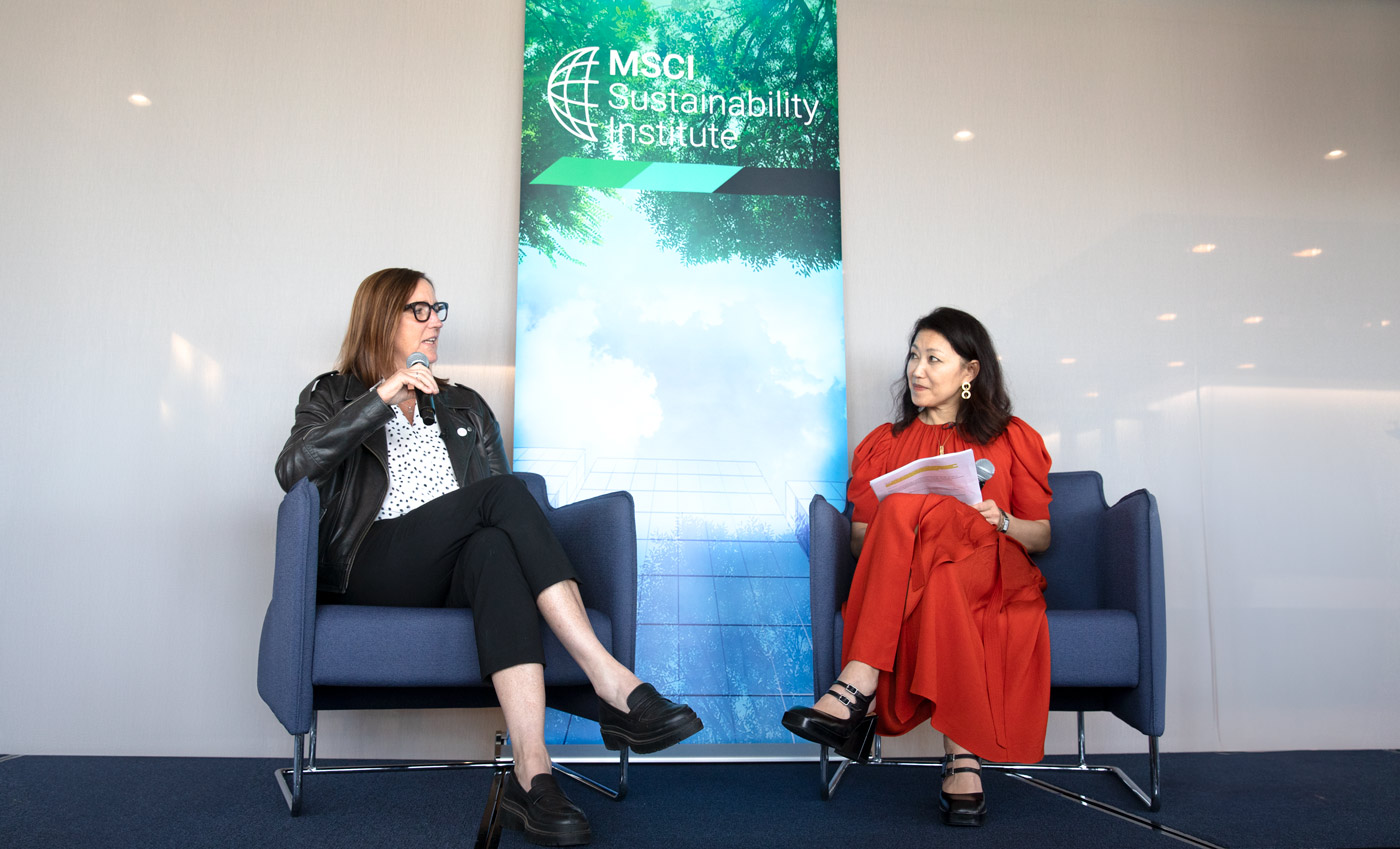Can sustainable investing find its footing amid a wave of critical scrutiny?
That was the question on the table during an afternoon of discussion hosted by the MSCI Sustainability Institute on Tuesday that covered current challenges and opportunities in the field.
The gathering convened leaders from finance, academia and business to untangle the latest data on sustainability and performance, explore divergence in ESG ratings, examine the role of diversity in creating value, and address misconceptions that have set sustainable investing up for self-reflection.
The conversation was full of practical insights for investors and corporate sustainability leaders alike. Here are some that stood out for us.
Curating conversations that drive sustainable value
We convene investment-industry practitioners, academic researchers, business leaders and policymakers for compelling encounters designed to produce clear thinking about the creation of sustainable value.
Watch the highlights from our recent event where we took a reality check of sustainable investing
The value of a reality check
While society looks to sustainable finance to accelerate the transition to a greener global economy and close gaps that governments can’t fill, “we as an industry are challenged every day by skepticism,” observed Linda-Eling Lee, head of the MSCI Sustainability Institute. That includes “skepticism about what sustainable finance has delivered and about the motivations of the major players and what everyone is trying to achieve.”
- Lee suggested three principles to govern the conversation: objectivity, pragmatism and innovation. “These are the key principles that underpin the work we do here at the MSCI Sustainability Institute,” she noted.
“
The backlash against sustainable investing has solidified my conviction around fiduciary duty,
Sharon Hendricks, a professor at Los Angeles City College, board member of the California State Teachers Retirement System, and advisor to the MSCI Sustainability Institute, left, tells Linda-Eling Lee, the Institute’s founding director.

Sustainability and performance
Academic research indicates three propositions for investment strategies, suggested Ulrich Atz, research fellow at NYU Stern School’s Center for Sustainable Business, who has reviewed the evidence: ESG integration seems to perform better than negative screening, sustainable investing may provide “a safe haven” in times of crisis, and managing for a low-carbon future appears to improve financial performance for firms though it is not obvious how that translates into future earnings.
- Though investors start with the research, the conversation about sustainability moves quickly from theory to practice, “and lands somewhere around risk reduction or long-term value creation,” observed Daniel Rourke, head of ESG integration at J.P. Morgan Private Bank, who noted that the focus with sustainability funds tends to fall on climate and corporate governance.
- Kelly Shue, professor of finance at Yale’s School of management, suggested “a strategy that rewards companies with credible transition plans,” based on research by Shue and Samuel Hartzmark finding that a misguided focus on percentage reductions in emissions rewards green firms for economically trivial reductions in emissions while increasing financing costs for emissions-intensive firms. “Portfolio decarbonization pushes brown firms to short termism such that they pollute more,” said Shue. “We want people who care about the environment to own the brown assets.”
- Olivier Souliac, head of indexing for Xtrackers products at DWS Group, suggested turning questions of performance around: “Is it fiduciary to ignore ESG-related risks when there is data about them?” he asked. Nor is defining sustainability for performance easy: “There is not one definition of ESG; every client’ has their own definition in line with their sustainability agenda,” Souliac suggested. In Europe, the question whether your approach to sustainability creates excess return “will be very different from one client to another,” he said.
- Though much research into sustainability focuses on listed companies, unlisted companies increasingly “see sustainability as operationalizing excellence” and are wondering whether becoming an employer or operator of choice creates “a premium that translates to lower cost of capital or better valuation,” suggested Paula Luff, director of sustainability research and engagement at DSC Meridian Capital, who reported that unlisted companies “are very focused on financially material sustainability issues.”
The value of (and challenges with) engagement
Though DWS engages with portfolio companies on sustainability, engagement “can be hard work,” noted Souliac, however necessary. “It’s like diplomacy; it never works until it does.” He added that the effectiveness of engagement “is all the more effective the more you hold in a company,” noting differences in company responsiveness between DWS’ engagement with European companies compared with firms domiciled elsewhere.
- There’s effectiveness in numbers, suggested Atz. “If you have a critical mass, you have much more cost-effective engagement than if you’re the only person.”
- It’s not easy, agreed Carine Smith Ihenacho, chief governance and compliance officer, Norges Bank Investment Management, who noted that the lion’s share of financed emissions in Norges’ portfolio are concentrated in about 70 companies. Norges creates performance indicators for every company it engages, Ihenacho reported, citing the need for companies to have interim and net-zero targets and transition plans. “That’s why we’re comfortable with brown companies, if they’re going to green from brown,” she added.
- Sharon Hendricks, a professor at Los Angeles City College and board member of the California State Teachers Retirement System (CalSTRS), noted that CalSTRS has doubled-down on engagement in conjunction with industry initiatives such as Climate Action 100+ and expressed her disappointment with the results of a recent proxy vote by shareholders at Exxon who re-elected the company’s nominees following votes by CalSTRS and other investors against all of them
- “It’s a marathon, not a sprint,” suggested Ihenacho, who commended CalSTRS and counseled patience. “Consistent work over the long term gets results.”
“
Just because ratings don’t correlate doesn’t mean they have no signal,
notes MIT’s Florian Berg, discussing divergence in ESG ratings.

Divergence in ESG ratings
Jon Hale, former head of sustainability research at Morningstar, noted the evolution of the marketplace for sustainability data. Twenty-five years ago, “it was hard to get a handle on how a company was managing issues like environmental impact; we didn’t have the data,” he recalled. “Fast forward to today, and responsible investing is stuck with too much sustainability data and investors struggle to make sense of what it all means.”
- “Just because ratings don’t correlate doesn’t mean they have no signal,” suggested Florian Berg, research scientist at MIT’s Sloan School of Management and co-founder of The Aggregate Confusion Project, whose research shows that differences in measurement drove a majority (56%) of the divergence among ESG ratings, with the remainder driven by scope (38%) and weight (6%).
- “I don’t think we have too much ESG data,” said Ihenacho, who stressed that Norges “does not use a single metric to do anything.” Instead it combines ratings with climate data and data that Norges itself develops “to form an opinion whether to under- or overweight,” she noted. “I think we need more data; it’s about how you use it.”
- “ESG data is a starting point to inform-decision-making,” noted Limin Yang, managing director for real assets, sustainability and climate change at CPP Investments. “From there, we do engagement to understand the nuance,” he explained, noting that a company can have low ESG ratings but a strong culture on sustainability. That’s why CPP also wants to know the credibility of companies’ disclosures, Yang added.
- Ratings also reduce the cost of due diligence for investors who may not have the resources of a big investors like CPP Investments. “We screen hundreds of deals annually, but it doesn’t make sense for every investor to spend millions to do this,” he noted.
“
I think we need more sustainability data,
said Carine Smith Ihenacho, chief governance and compliance officer at Norges Bank Investment Management.

The importance of transparency
Divergence itself is not the problem; a lack of convergence can be good if ratings are used for different purposes, provided that investors know the rationale that underpins them, Iheanacho explained. “The problem is the lack of transparency behind the ESG rating,” she stressed. (Note: MSCI publishes its complete ESG ratings methodologies, which are available here.)
- Transparency should be the aim of any regulation of sustainability ratings, agreed Berg. “Regulation should focus on getting the incentives right, not reducing distance between theoretical measures,” he suggested.
- Ratings firms “have a very important role to play,” according to Berg, who noted that while regulations such the European Union’s Corporate Sustainability Reporting Directive or the growing number of countries mandating climate disclosure may increase disclosure, “the data needs to be put in context.”
- While ratings are good as a reference, they are “less good for risk prediction,” asserted Berg, who suggested a hypothetical company’s asking cynically how much it needs to be able to reduce its gender gap to be able to put 100,000 more tons of greenhouse gas emissions into the atmosphere. Still, investors address this, Berg noted, by examining the raw data that underpins ESG ratings as much as they rely on the rating itself.
Diversity and the creation of value
The biggest investors increasingly vote against corporate directors based on a failure by companies to reduce their climate impact or to diversify their boards, reported Reena Aggarwal, a professor of finance at Georgetown University, who noted that diversity encompasses not just demographics but also skill sets, age and culture.
- “The evidence is mixed” on the tie between board diversity and performance studied by academics, Aggarwal reported, noting that nine studies have found negative relation, three found mixed evidence and 11 found positive return.
- “The planet is a diverse place, which means diversity is material to our core business,” said Matthew Sekol, ESG advocate working at Microsoft, citing the company’s mission “to empower every person on the planet to achieve more.” “We can’t do that without DEI,” Sekol noted, adding that such efforts also save the company money. “If we can lead with inclusion, we can lower our costs,” he added, noting that it can be costly for companies to replace a technology worker.
- DSC Meridian Capital invests in the high-yield universe, where disclosure is limited and sustainability risks may be mispriced, Luff explained. “There is no replacement for talking to management, I’ve yet to read a 10-K where talent is listed as an existential risk,” she noted.
- You have to view diversity “from a qualitative standpoint” because ticking a box could never capture “who I am as an individual,” suggested Mamadou-Abou Sarr, co-founder and president, V-Square Quantitative Management. “You can’t attribute the outcome of a company to a single color, ability or gender.”
- Diversity “is a big challenge in the U.S. right now,” observed Sekol, noting different outcomes in lawsuits against Hello Alice, which recently won dismissal of a court case against it, and one against Fearless Fund, whose grant program a court found to be discriminatory.
- Luff noted the value of a tailored approach. “We want to see companies create value for the long term, she noted. “We have found that going to a company with data that shows market leadership and an offer to help management build a better strategy to be more effective than “please two women on your board.
- Diversity is not yet high on investors’ agenda in Europe, perhaps because they are so busy with other sustainability aspects such as climate, suggested Souliac, who noted that for investors, focusing on companies with an objective to increase diversity can bring with it an outsize focus on large companies. “Diversity is all the more relevant for the largest companies because their decisions are usually not made by one person,” he noted. “If as an equities investor I look into social issues, am I getting the performance of companies that do socially well or simply a size bias?”
- Standards and targets will only get companies and investors so far, suggested Sarr, citing release by the CFA Institute two years ago of a code for diversity, equity, and inclusion. “I don’t think programs solve issues,” compared with addressing diversity from within, he said. “A company that has a good culture will be a diverse company that attracts the right talent.”
- Luff agreed, noting that inclusion demands a conversation. “Tell me about your recruiting process how you review resumes, and the recruiting relationships and intern programs you have,” she suggested. “There are a whole host of questions you have to ask that you can’t fit into a datapoint.”
- Diversity increasingly matters as new generations of workers fill the workforce, added Luff, citing a survey that half of members of Generation Z would not accept an offer from a company that did not have diverse leadership, while more than two-thirds are dissatisfied with their company’s steps for creating a diverse workforce. “If that doesn’t scream financial relevance I don’t know what does,” she observed.
“
The planet is a diverse place, which means diversity is material to our core business,
noted Matthew Sekol, ESG advocate working at Microsoft.


